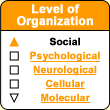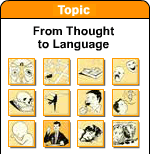|
|
|
|
 |
Communicating in Words |
 |
|
|
|




A
Monthly Podcast On Cognitive Science
Why
You Can Have No More Than About 150 Real Friends
Summer
school in cognitive sciences 2014 : Web Science and the mind
Persistence
of social signatures in human communication
Some researchers
try to identify archaeological traces of symbolic
thought among our ancestors in Africa, Europe,
and the Middle East. These researchers believe that if they
can find such traces, they necessarily imply that the people
concerned had a sufficiently elaborate communication system
to share with one another the meanings behind the symbols
they used. (In contrast the methods of manufacturing tools
could presumably be shared by simple imitation.) In short,
these people must have had a language.
The material artifacts of a symbolic culture may include personal
ornaments, decorated tools, engraved bones and stones, graves,
tomb objects, notation systems, musical instruments, and so
on. All of these objects bear representations that have
no iconic relationship with their meaning. They
can also refer to non-instrumental behaviours that occur in
human populations. |
Language
certainly constitutes an important asset for survival, but
less so for the individual than for the group. Language is
above all a shared attribute of a group of individuals, and
in this regard, it favours the selection of groups and not
of particular persons. This is the case for any animal community
that has an effective means of communication. For example,
like humans, bees and ants can react as a group to an outside
event, thus becoming the subject of evolution by selection
of groups rather than selection of individuals. |
“The
first steps toward language are a mystery.”
- Steven Pinker
“The question of where language comes from may simply
be unanswerable.”
- Richard Lewontin
“This task intrigues people because it’s about
us. But that doesn’t make it a scientific question.
It may be important for us to know where we came from, but
if we can’t answer that question scientifically, we
can’t answer it. If you want to tell stories, well
then, tell stories.”
- Noam Chomsky |
|
|
The origins of language have given rise to
many debates over the years. In 1866, the Linguistics Society of
Paris even declared this question irresolvable and thenceforth refused
to accept any more papers on the subject. Because spoken language
is by definition impermanent, we have only indirect evidence of
how it emerged. That is why so many different hypotheses have been
offered about the origins of language, each one more imaginative
and speculative than the one that preceded it.
First, there are what might be called the vocal theories of
the origins of language. According to these theories, about 100 000
years ago, certain changes in the mouth and the pharynx (follow
the Tool module link to the left) combined with an increased brain
volume to give human beings voluntary control over vocal outputs
that up to then had been more like instinctive cries. There are
many variants of these vocal theories.
Some authors speculate that human language arose from the development
of onomatopoeia: the imitation of sounds in the environment.
Other authors say that language developed from cries of joy,
cries of pain, and other involuntary exclamations. Still others,
including Charles Darwin, argued that people developed oral
language by using their mouths to imitate the gestures of an existing
language for which they had until then used their hands.
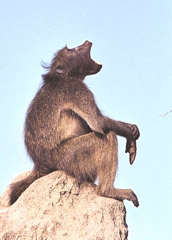 |
According to another
hypothesis, the use of arbitrary symbolic sounds developed
from the cries that primates used to alert one another to
the presence of predators, of edible or poisonous foods,
and so on. Other yet more sophisticated theories propose,
for example, that human language became so elaborate because
early humans’ cries and vocalizations revealed their
mental states, and so some individuals learned to imitate
these sounds to obtain certain selective privileges and advantages.
|
Another school of thought posits the gestural
theory of the origins of language. This theory holds
that one of the first effects of the transition to walking on
two legs was to free the upper limbs and make them available
for gestural communication. Subsequently, vocal language developed,
thus freeing the hands for other uses.
Research on the sign language used by deaf people has yielded
some arguments that support the gestural theory. These studies
have shown that from a grammatical standpoint, sign language
is just as sophisticated as spoken language. They have also
shown that sign language calls on the same “language areas” in
the left hemisphere as spoken languages do (follow the Tool module link to the
left), and in particular Broca’s
area, which lies very close to the motor areas that control the arms and
hands. The gestural theory of the origins of language would also explain why
chimpanzees can learn the rudiments of sign language but cannot acquire spoken
language.
| Gestural theory
might also explain why the stone tools used by the first hominids
evolved so little for nearly 2 million years, even though these
early humans’ brain size was increasing. If they were
using their hands to communicate, perhaps that made them less
available for refining their stone tools. |
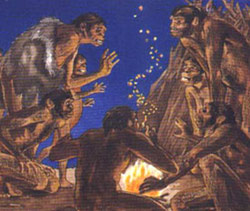 |
The proponents of the gestural theory of the origins of language
believe that the transition to spoken language probably proceeded
gradually until about 50 000 years ago, when spoken language became
far more predominant, thus permanently freeing the hands to accomplish
the staggering technological and artistic advances of that period.
 |
 |
According to another set of theories, language emerged from the complexity
of the social world in which primates lived. In this
regard, these theories contrast with the other theories that
emphasize exchanging information about the physical environment
for pragmatic purposes such as more effective hunting.
British anthropologist Robin Dunbar’s “gossip” theory
is one of these theories based on social complexity. Around the
mid-1990s, Dunbar pointed out that the majority of people’s
conversations are devoted to gathering news either about the people
they are speaking to or about third parties: in other words, to
gossiping. For Dunbar, the primary function of language therefore
is to exchange information about the individual’s social
environment: who is trustworthy, who has made alliances with
whom—in short, the usual gossip.
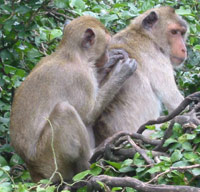 |
In primates, it is mutual grooming that serves
this social function, strengthening hierarchies and promoting
reconciliation after conflicts. Dunbar believes that during
hominization, as the number of individuals in each group
increased, language simply became more effective than grooming
as a tool for social cohesion.
|
Other authors, such as French sociolinguist Jean-Louis Dessalles,
assert that humans began to talk because they are first and foremost political
animals. In this sense, the great advantage that language
conferred on early humans would have been the ability to persuade
other people to form alliances, or to accept the truth of something
that was not happening before their eyes. Thus language would have
emerged because hominids needed a way to choose their allies within
groups whose social structures were becoming more and more complex.
Still other authors, such as French cognitive linguist Bernard Victorri, emphasize
that at a certain point in its evolution, the human species experienced the need
to formulate laws to manage the crises arising from the increasingly
complex mental lives of the members of the social group. These laws were expressed
in myths such as are recounted in all human societies—“This happened,
and it could happen again, but it must not.” Such tales may have promoted
the emergence of the narrative complexity that is unique to the human species.
But besides the nature of the mechanisms by which language originated, one other
question has been haunting linguists for many years: whether
language was invented just one time, or many.
|
|



